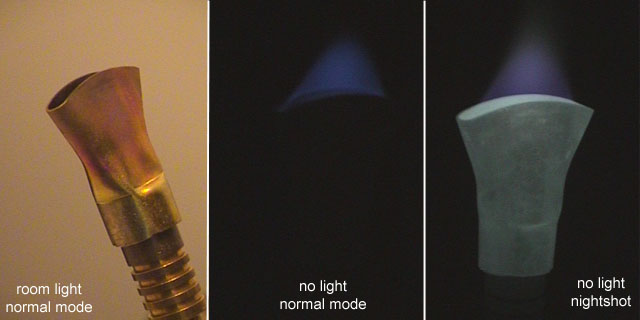 |
 |
 |
 |
The human eye is sensitive to light from about 400 nm (blue) to about 750 nm (red) and longer wavelengths are considered infrared. The wavelength sensitivity of the Sony "Nightshot" mode extends to a wavelength of approximately 1 micron or 1000 nm, which is near-IR. You can see some actual spectra I took here.
Above are two shots taken with the Sony TR7000 Digital 8 camera. At left the camera is in normal mode, and at right is in nightshot mode with an additional external IR longpass filter (Edmund Scientific, #H43949, $7.00) which blocks most light above 675 nm. It's interesting how bright the trees and grass are in the infrared band. You'll notice that, at right, the grass is brighter than the sidewalk. By contrast, the roof of the building and the road surface is darker. I notice a number of materials which appear black to the eye, plastics especially, look very bright or reflective in IR, although this not universally true.
Several people have emailed me asking about thermal cameras. If you want to measure the temperature of anything less than visibly red-hot, you need a mid-IR camera (3 microns and longer) which normally uses a cooled imaging sensor and is very expensive (not a consumer item). I have tried out such a thermal IR camera; see examples here. The Digital8 and MiniDV cameras with "nightshot" mode go to about 1 micron, which will pick up objects which are almost but not quite red-hot: perhaps around 600 C (1100 F). For instance, the heating elements on an electric stove top, or as shown below, a propane torch nozzle.

By the way, the Nightshot mode switch on the Digital 8 camera does two things: 1) physically move the IR-cut filter aside from the CCD and 2) disable the exposure controls, fixing the exposure at 1/60 sec and maximum aperture. This second function is controlled by an internal microswitch triggered by the lever arm that moves the filter. I disassembled the camera and moved the microswitch from the path of the lever arm, enabling a reasonably exposed IR image outdoors during the day. If want to try this yourself, look here. Without this modification, you would need a very dark filter to avoid overexposure using Nightshot during the day. Even with the external IR filter, which absorbs almost all visible light, the exposure of the right-hand picture at the top of the page was f/2.4 at 1/3000 sec. There is more information about nightshot usage with Sony camcorders on this page.